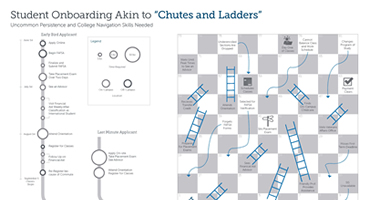By Jonathan Turk
Living in the DC area means I rely heavily on the Metrobus system to commute to work and get around the city. The other day, before I could get my earbuds in, I noticed that transit authority had come up with a new way to raise revenue: audio advertisements on the bus. My first reaction was, “Great, my 40-minute commute to ACE is now going to be one long infomercial.”
But the second ad that came on caught my attention. “Some people still think an education from Northern Virginia Community College is just . . . settling,” the narrator said incredulously. The ad went on to talk about Northern Virginia Community College’s (NOVA) excellent faculty, lower tuition prices, and the connections between our local labor market needs and their educational offerings.
While the ad was clearly trying to encourage more students to enroll at NOVA, it was also doing something more—challenging misperceptions about the quality and value of the education students can receive at their local community college. The ad was taking on the community college stigma.
Those in the community college sector are no strangers to the myths and misconceptions that lead many students and their families to view community colleges as second-class institutions. I won’t spend any of my limited space here rehashing them. Rather, let’s focus on some key facts about community colleges and then discuss how we can dismantle this harmful stereotype.
Fact 1: Community colleges serve more students than any other single sector of higher education.
In 2016, community colleges served nearly half (46 percent) of all undergraduates enrolled in higher education. That’s over 8.5 million students. Public four-year colleges and universities enrolled 31 percent, followed by private nonprofit four-year institutions at 15 percent, and for-profit institutions at 8 percent.
Fact 2: Community colleges provide excellent educational opportunities at a lower price.
Community colleges provide opportunities for students to learn and acquire the skills necessary to be competitive in today’s workforce. By providing access to high-quality faculty, smaller class sizes, and a variety of postsecondary credentials, community colleges prepare students for good jobs and—for those who desire it—a pathway to a bachelor’s degree.
Community colleges do this and so much more while also keeping tuition costs lower. According to the College Board, the average published in-district tuition and fees charged by community colleges in 2017–18 was $3,560. Public four-year institutions charged $9,980, private nonprofit four-year institutions charged $34,700, and for-profit institutions charged $14,000.
Fact 3: Almost half (49 percent) of all students who earn a bachelor’s degree first enroll in a community college.

Fact 4: Community college graduates have greater employment outcomes and earn more than non-graduates.

How to end the stigma
With the facts on the table (or on the bus, as it were), what can be done to promote community colleges and remove the stigma? I don’t have all of the answers, but here are some suggestions.
Promote community colleges as a first choice
Take a closer look at the messages students in elementary and high school receive about community colleges. Too many students are made to think of community colleges as a second or fallback option. Instead, high school counselors and others in the education sphere should share the facts about community colleges with students and their families to demonstrate that these institutions provide both a quality education and a good value.
The national student-to-counselor ratio is now almost 500 to 1, double what is recommended by the American School Counselor Association. These numbers mean school counselors are often unable to provide all of their students with comprehensive college and career counseling. But even when a school district has more counseling resources, it’s not clear that the counselors are fully equipped to help students consider their community college options.
According to a recent report from the National Association for College Admission Counseling, while high school counselors felt generally prepared to advise students about community colleges, many felt less knowledgeable about transfer policies at local four-year colleges and the pros and cons of community colleges versus for-profit colleges. This is a major problem, especially given the much lower cost of attending a community college and the role community colleges play in transfer.
We need more professional development for counselors around community college admissions and transfer. But it’s not the only solution. Classroom educators can also help support the career exploration of their students. Teachers should look for opportunities to integrate college and career exploration activities into their existing course content and assignments. Empower students to begin research and consider a wide variety of potential professions and education options. Educators who attended a community college themselves should share their stories as yet another way to reinforce the value of a community college education. Don’t miss an opportunity to show students a real-life example of the success a community college education can provide.
Eliminate barriers to transfer
For those that attend community college, after six years only about a third transfer to a four-year institution. Why? A recent study from the Government Accountability Office found that students lost 43 percent of their credits when transferring from one higher education institution to another. That works out to an average of about 13 credits lost per student. Even more, when credits are accepted, they may only be applied as elective credit as opposed to major credit.
But transferring colleges is not uncommon among today’s students. According to the National Student Clearinghouse, almost 40 percent of all students enrolled in higher education transferred at least once within six years of first enrolling. If we want students and their families to have confidence in the quality of a community college education, then higher education leaders across all sectors need to promote transfer pathways that accept the credits earned at community colleges. This will require greater collaboration among community colleges and four-year institutions to produce better and more efficient transfer and articulation policies.
Reject educational elitism and better support community colleges
As a society, we need to have a discussion about inequality and elitism in education. Where an individual grows up, their race, and how much money is in their bank account still play an unacceptably high role in their access to high-quality education at all levels. As the recent high-profile college admissions scandal makes clear, our society equates exclusivity and large sticker prices with quality. The more expensive the tuition and the fewer individuals admitted, the better the quality—or so the logic goes. This mindset, which contributes to the idea of community colleges as inferior, is the same line of thought (along with a sense of unbridled entitlement) that led dozens of individuals to pay hundreds of thousands of dollars to fraudulently ensure their children a place at a highly selective university.
Community colleges accept 100 percent of applicants with a high school diploma or equivalent credential and offer high-quality educational opportunities, all while keeping their tuition low to maximize access. This should be viewed positively rather than with skepticism. We need to rethink our higher education finance policies to adequately fund our community colleges and other public less-selective and open-admissions colleges and universities. Policymakers should do more to end elitism by supporting and rewarding institutions that provide the greatest access to low-income, first-generation, and other underserved student populations. Help these institutions develop additional capacities to continue to serve and better serve students of all backgrounds.
Northern Virginia Community College got it right: an education at a community college isn’t settling. But the millions of students that could be best served by a community college need more encouragement than just an ad on a bus. They need real support from their counselors, from four-year colleges and universities, from policymakers, their families, and from society as a whole.
It’s easy to tune out calls for community colleges to receive that support, but it’s harder to ignore the facts. Let’s acknowledge that a real solution to so many of our challenges around affordability, access, and success lies in our community colleges.
If you have any questions or comments about this blog post, please contact us.



